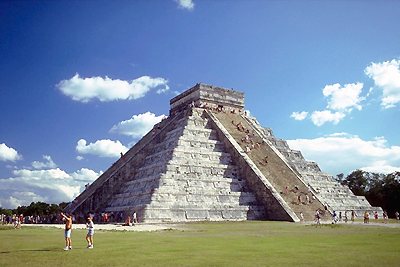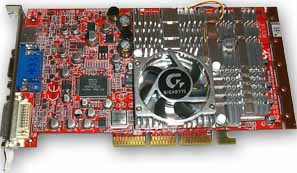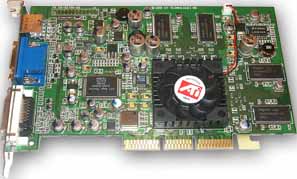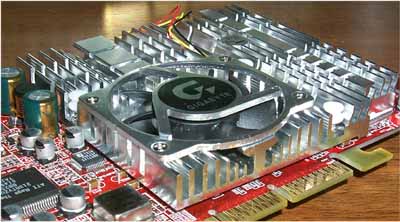
Deeply in the jungles of Mexico and Guatemala along
the Yukatan peninsula spread out fairy temples and palaces of the
mysterious people of Maya. When Europe was still dreaming in the
Sombre Centuries these innovative people were able to make up a
celestial map, create an original American writing and reach the
summits in mathematics and calendar. They didn't know about metallic
instruments, pack animals or even about a wheel, but they were able
to build huge cities with wonderful masterpieces of architecture.
Their heritage in stone which lived through the centuries up to
our days strike modern travelers in Palenque, Tikal, Tulum, Chichen
Itza, Copan and Uxmal where almost 7 million descendants of the
classical civilization of the Ancient Maya are living.

So, let us be carried from snow-covered Canada
and hot Taiwan to South America where the Civilization of Maya prospered
quite a long time ago.
It is interesting that 3dfx sent its workers to
Africa so that they could get inspiration for creation of Voodoo
and Banshee. However, the sad events of disappearance of 3dfx made
Cigabyte think whether it was worth bowing to the still existent
supernatural cultures as Voodoo has already taken away his creator.
The intentions of Gigabyte to combine in its new
product innovations of 3D graphics and magic forces of shamans terrified
ATI, and quite a few of its stuff moved to Taiwan to prevent it...
And after that they decided to go with the mysterious spirit of
Maya.
About 300 B.C. Maya adopted a theocratic system
of government based on aristocracy and kings. During the whole classical
period from 200 to 900 A.D. the society was based on principles
of distinct separation. It consisted from many independent states
which were either agricultural communities or large urban settlements
appeared around religious centers. Their started collapsing about
900 A.D., and the reasons are not known yet. The south maya left
their cities. And when the north maya dissolved in tolteks in 1200
the dynasty of maya passed away.

Their life was based on distinct laws violation
of which could result in a catastrophe. It seems that the today's
product is a hint for ATI that its policy full of hesitaitons and
unreasoned actions may have the same consequences.
The video card named after MAYA is the first attempt
of Gigabyte to combine advanced 3D technologies and the name of
Maya.
Theoretical and analytical materials and reviews
of video card concerning functional peculiarities of the ATI RADEON
8500/7500 GPU
We are going to continue examination of 3D functions
of the RADEON 8500. And today we will take a look at operation of
1.4 pixel shaders in the 3DMark2001 SE.
But first of all, let's look at the Gigabyte's
card.
Card
The Gigabyte MAYA AP64D-H RADEON 8500 Deluxe has
AGP x2/x4 interface, 64 MBytes DDR SDRAM located in 8 memory chips
on the right and back sides of the PCB.



Hynix produces 3.6 ns memory modules which corresponds
to 275 (550) MHz. The card operates at the frequencies of normal
RADEON 8500 - 275/275 (550) MHz.
The culture of maya inherited achievements and
ideas of the Olmecs - an earlier civilization, they developed astronomy,
a calendar system and hieroglyphic writing.

Maya had a well thought-out and richly decorated
architecture consisted of pyramids, palaces and observatories built
without a single metallic nail. Maya were excellent farmers, weavers,
potters, builders and traders.
Although the Ancient Maya didn't know how to use
metals our maya has heavy metallic armor. Later we will speak about
them, and now let's compare it with the reference card.
Gigabyte MAYA AP64D-H RADEON 8500 Deluxe


ATI RADEON 8500


The left parts are similar, but the right ones
differ. Let's take off the cooling system:


The memory chips are located at the same places,
but the right part is made larger, and the card looks more impressive:

The cooler consists of two heatsinks. The larger
one is installed on the right side, and the smaller one - on the
back side.


Both heatsinks are all-metal details which accurately
cover the memory chips, and the small heatsink has a special jut
for taking off heat from the back side of the chip.
The card supports hardware monitoring via the VTuner
utility

where you can learn about temperatures, voltage
and fan speeds. The program controls two coolers (for GPU and memory).
On the top of the card there is one more connector for the second
cooler (they even drilled a hole in the heatsink for the capacitor):

There is no additional cooler onboard, but there
is space for it:

The cooler is to be attached so that it may turn
around the axis of mounting to the card.
Now take a gander at the big heatsink:


Some of the maya believed that the sky was multi-level
and was supported on the corners by 4 strong deities called bakabs.
Other believed that the sky was supported by 4 trees of the corresponding
color and form with a green ceiba in the center.
This is the case: the heatsink is supported by
4 pins which sandwich the card. The fan is placed right above the
GPU.

Such configuration of the cooler can probably impede
installation of the card into some mainboards which have capacitors
between AGP and first PCI slots:

The heatsink is separated from the capacitor by
just 2 mm. Here the capacitor is as high as the AGP slot (EpOX 8KHA+),
but there are boards with higher capacitors.
The Gigabyte MAYA AP64D-H RADEON 8500 Deluxe card
is equipped with three connectors: VGA, DVI and TV-out.

The card ships in a Retail package which includes:
- User manual;
- CD with software;
- 6 CDs with games and a PowerDVD XP 4.0 player;
- DVI-to-D-Sub adapter;
- S-Video extender;
- S-Video-to-RCA adapter.
It's only the PowerDVD XP which is new, and the
games are quite old (F.A.K.K.2, Serious Sam, Motocross, Rally 4x4
etc.).
Overclocking
It should be noted that although the VTuner helps
to overclock the card it does something wrong with memory timings;
the same frequency increase of the GPU and memory via VTuner and
via PowerStrip brings in different results (when PowerStrip or the
new beta version of the RivaTuner are used the performance grows
much faster). The card worked stably at 300/305 (610) MHz.
Note:
- in course of overclocking you must provide additional cooling,
in particular, a fan for the card (first of all, for its memory);

- overclocking depends on the definite sample, and you shouldn't
generalize the results of one card to all video cards of this
mark or series. The overclocking results are not the obligatory
characteristics of a video card.
Test system and drivers
Testbed:
- Pentium 4 based computer:
- Intel Pentium 4 2100;
- ASUS P4T-E (i850) mainboard;
- 512 MBytes RDRAM PC800;
- Quantum FB AS HDD, 20 GBytes;
- Windows XP.
The test system was coupled with ViewSonic P810
(21") and ViewSonic P817 (21") monitors.
In the tests we used ATI's drivers of v6.032. VSync
was off, S3TC was off!
The card comes with ATI's drivers of v6.015.
For the comparative analyses we used the following
cards:
- Reference card NVIDIA GeForce4 Ti 4400 (275/275 (550) MHz,
128 MBytes);
- ABIT Siluro GF3 Ti500 (NVIDIA GeForce3 Ti 500, 240/250 (500)
MHz, 64 MBytes);
- ATI RADEON 8500 (275/275 (550) MHz, 64 MBytes, driver v6.016).
Test results
2D quality is flawless. You can work comfortably
in 1600x1200@85 Hz. The dual-head support of such cards was concerned
earlier.
For estimation of 3D quality we used:
- Quake3 Arena v.1.17 (id Software/Activision) - a gaming test
which demonstrates operation of a card in OpenGL with the Quaver,
a standard demo benchmark of the Q3DM9 level with large textures.
- Return to Castle Wolfenstein (id Software) - a gaming test
which demonstrates operation of a card in OpenGL with the Checkpoint
demo benchmark.
- 3DMark2001 SE (MadOnion) - a synthetic test which demonstrates
operation of a card in DirectX 8.1;
Quake3 Arena
quaver, highest quality mode
The tests were carried out in 32bit color modes
with the maximum detailing level of textures and geometry (r_subdivisions
"1" r_lodCurveError "30000").

We used the NVIDIA GeForce4 Ti 4400 as one of the
contestants because NVIDIA positions this card as a direct competitor
for the fastest card from ATI, i.e. the same as we are examining
today. But currently the ATI RADEON 8500 and its clones are fighting
against NVIDIA GeForce3 Ti 500.
So, the GeForce4 Ti 4400 is an unquestioned leader.
But even the GeForce3 Ti 500 outscores the flagship of ATI+Gigabyte
by a great margin.
Return to Castle Wolfenstein (Multiplayer)
Checkpoint, High Quality Modes
The tests were carried out in 32-bit color mode
at the highest detailing and quality level of textures.

The situation is the same.
3DMark2001 SE
We got the new SE version of this packet.

Both RADEON 8500 based cards worked with different
driver versions so that you can compare not only cards but also
software versions from ATI.
As you can see, the new version of the ATI's drivers
helped much. On the whole, the RADEON 8500 takes the first place
after the GeForce4 Ti 4400.
Game1, Low details

Here it is the Gigabyte MAYA AP64D-H RADEON 8500
Deluxe which takes the second place after the GeForce4 Ti 4400.
Taking into account that prices for these cards are much lower than
for GeForce3 Ti 500, the choice is obvious.
Game2, Low details

The RADEON 8500 has grown much stronger in this
test. And although the GeForce4 Ti 4400 wins the GeForce3 Ti 500
falls behind by a great margin.
Game3, Low details

The Gigabyte MAYA AP64D-H RADEON 8500 Deluxe and
the GeForce3 Ti 500 are beating each other in different resolutions.
In the high resolutions the RADEON 8500 falls behind.
Game4

This test seems to be the most favorite for ATI.
The RADEON 8500 outscored the GeForce3 Ti 500 and keeps up with
the GeForce4 Ti 4400.
Advanced Pixel Shader



This test is seen in the 3DMark2001 SE and demonstrates
operation of cards using 1.4 pixel shaders (or shaders of v1.0-1.1,
but a water surface is formed in two passes).

Note:
- when the DXTC (texture compression) technology is used the
results of the RADEON 8500 grow up considerably which never happened
in the 3DMark2001 (in gaming tests)
- Although the RADEON 8500 forms a water surface (this is a main
object in this test) in one pass and the GeForce3 Ti 500 - in
two passes the latter doesn't lag behind by a great margin.
Once again I want to draw your attention to the
strange behavior of the RADEON 8500 when texture compression is
disabled; the results of the GeForce3/4 cards do not almost depend
on the DXTC.
In closing I'd like to recommend you read our reviews
on cards (see the beginning of the article) based on the RADEON
8500. In our 3Digest
you can find performance results of these cards on different platforms.
Conclusion
"The Maya saw its golden age and times of decay,
some city centers were replaced with others. The reason is probably
loss of their religious beliefs, but even today lots of Indians
revere traditions of the Ancient Maya.
I hope that this product named after MAYA will
find its users and will become one of the most popular cards carrying
excellent 3D graphics, dual-head support and good TV-out quality.
In the beginning Gigabyte is going to price the card at $250 (retail).
Highs:
- Excellent quality of the card;
- Good performance in 3D;
- Full support of all functions from DirectX 8.1 and of the TruForm
technology;
- Attractive guiding prices;
- Good Retail package including DVI-to-D-Sub and S-Video-to-RCA
adapters.
- Original design and hardware monitoring support;
Lows:
- Possible difficulties in installation of the card into mainboards
which have high capacitors between AGP and PCI slots.
Write a comment below. No registration needed!
